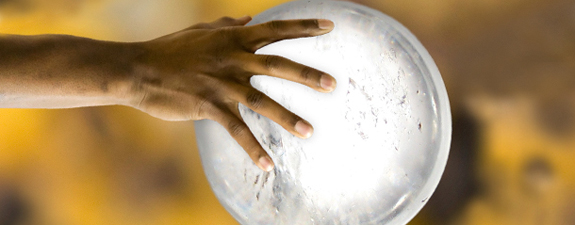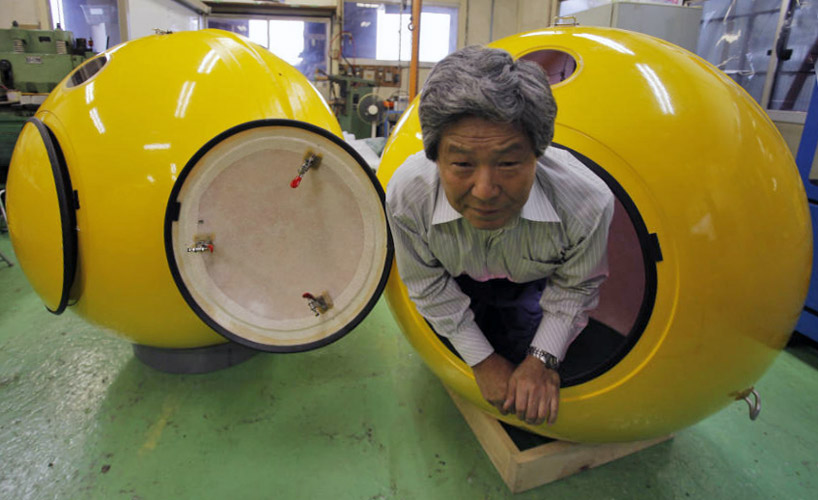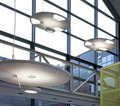Reclaimed Wood Products by Pioneer Millworks
by: Core77, 2011-10-05 18:00:00 UTC

Pioneer Millworks has been cranking out wood products since 1988, and the cool thing is the majority of it is reclaimed from existing structures rather than cutting down trees.



(more...)


 New LineUp Material: From Milk Bottles to Countertops
New LineUp Material: From Milk Bottles to Countertops
by: Core77, 2011-10-06 19:00:00 UTC

Materials company 3form's 100 Percent is a resin panel made completely from recycled HDPE bottles. Formed into 4x8 sheets, it has good impact-, flame-, chemical- and abrasion-resistant properties that make it ideal for counterop and tabletop surfacing.
The company has recently figured out how to striate the colors and called the resultant product, pictured above, LineUp. Users have the option of ordering the stripes either lengthwise and crosswise, and we dig that they've rendered the hues from recycled milk and detergent bottles into design elements while simultaneously reminding the end user of the material's provenance.
(more...)


 Solar Entrepreneur Lynn Jurich: Sunny Days Ahead
Solar Entrepreneur Lynn Jurich: Sunny Days Ahead
by: fast company, 2011-10-06 15:33:31 UTC
What's the future of solar energy? Fast Company gets Crystal Ballin' with Lynn Jurich, cofounder of SunRun, which is flourishing in a season that has seen a few high-profile bankruptcies in solar energy.

For the latest installment in our futurist series of interviews, Crystal Ballin', we talk to Lynn Jurich, the 32-year-old cofounder of SunRun, which specializes in installing and operating solar panels on residential rooftops. SunRun's twist on the model is to retain ownership of the panels, sparing residents the tens of thousands of dollars it would cost to buy and install them themselves, thereby speeding adoption. Last month, the large solar firm Solyndra went bankrupt, leading to speculation about the future of solar. Jurich, for her part, is confident that it's going to be sunny.
FAST COMPANY: Tell me a bit about SunRun’s vision.
LYNN JURICH: We started the company five years ago, and we’re now the leader in residential solar-as-a-service. The inspiration for the company was that we saw all this investment going into solar technology, and we could see that solar was finally going to be cost competitive with other energy sources. Our thesis was that since homeowners pay the most for power, residential rooftops would be an important market. We go out there and sell the homeowner power that’s a price at least equal to what a utility charges, or less than that. We pay for the whole solar installation, and the homeowner just pays us for the electricity. And what this does for the grid is it helps us to move away from dirty, dumb, huge energy plants, where 40% of the electricity that we generate is wasted before it even reaches the end user.
What markets are you currently in?
 Today we’re in nine different states: Hawaii, California, Arizona, Colorado, New Jersey, Massachusetts, Pennsylvania, Maryland, and Oregon. In those places we can literally put up panels on residents’ rooftops at zero cost to them and save them money immediately.
Today we’re in nine different states: Hawaii, California, Arizona, Colorado, New Jersey, Massachusetts, Pennsylvania, Maryland, and Oregon. In those places we can literally put up panels on residents’ rooftops at zero cost to them and save them money immediately.
How is business faring?
We have about 14,000 customers today, and we’ve raised money to install about 750 million dollars' worth of panels on rooftops. Today we’re installing a million dollars’ worth every day in residential rooftops. We’re growing at a rate of over 100%.
How do you raise those numbers further? To what extent is solar a technological problem, and to what extent is it a financing problem?
The majority of it is not just financing, but a finance and business problem, that whole last-mile problem. The panels are reliable and affordable now, and the price has really come down, following a pretty predictable curve just like in other industries. The majority of the friction in the model is in financing definitely, because it’s a newish industry and a long-lasting asset. These panels last 20 to 30 years, and it’s difficult to get cheap capital against a 20-year asset when it’s less known. Other major problems are regulatory problems. So much of what we spend time and money and effort on is education and lobbying. An interesting fact is that in Germany, which doesn’t even require a permit for you to install solar panels, the gross cost to install solar is less than in the U.S. You can contribute a lot of costs to local red tape--there are huge soft costs that we could easily eliminate with less bureaucracy.
What proportion of your job is spent on politics, lobbying, and the like?
My time personally, 10 to 15%. But we have six full-time people in regulatory affairs. We actually spend more money in legal or regulatory efforts than we do in marketing.
You said that you offer solar at a price equal to or cheaper than traditional energy. Is saving money the only thing that will move consumers to be green? What about the old-fashioned appeal to the conscience?
We don’t believe that that’s a realisitc approach. “Pocketbook environmentalists,” we call our target customers. They make buying decisions based on value. The primary driver is cost and convenience, and the environment is a secondary nice-to-have. The mainstream is not willing to make sacrifices in cost or convenience.
I bet this kind of talk goes over great at Greenpeace rallies.
I’m on the board of the Sierra Club Foundation, and am myself a big environmentalist. But the way to make the biggest difference is to change mainstream behavior.
A couple solar companies have a fallen on hard times, lately: Solyndra is the latest to have gone through a high-profile collapse; Evergreen was another. How does SunRun gird itself against such catastrophes?
We’re technology-agnostic. A lot of people are investing in panels and hardware, and we don’t want to take a bet on that: We want to be the beneficiaries as those costs come down. The high-profile companies you’ve seen go bankrupt have almost been victims of the solar industry’s success--they’re hardware companies, and because cost has come down so dramatically over the last two years, they’re not able to compete. This is a growing market where there is a shakeout as the market develops. When Netscape failed, it didn’t mean the Internet was over. If you look at the fundamentals, the solar industry is healthy.
I had totally forgotten about Netscape. So energy is like the computing industry?
We used to have mainframe computers and dumb terminals, then we moved to the client-server model, then fully distributed on the Internet. We believe a similar thing will happen with energy industry.
How many times a day, when describing the current state of things, do you find yourself using the word “dumb”?
Thanks for pointing that out, I’ll have to watch that in the future! The way the system works right now, you have these centralized power plants, and the grid flows one way, and there’s no flow of information. I think what we’re moving towards is a smart grid where real-time information is feeding back and forth, as well as decentralized production. What happens today is you have to build capacity for peak demand. So on a hundred-degree day, power plants have to turn on these things like jet engines, which are really expensive and really dirty. When you look at the cost of peak power, it’s much more expensive today than solar. You have to look at the entire system and what it truly costs. The Northeast blackout in 2003 cost the economy 3 billion dollars. All we needed were 80,000 homes with solar for that to be avoided.
Time to look into the crystal ball. Where will residential solar power be in one year?
In a year I believe we’re going to have significant growth. I believe we will expand to an additional three or four markets where we’re cost competitive.
How about five years?
In five years I think it’ll start to become a meaningful contributor to our energy sources in the U.S. By “meaningful” I mean I think solar will be a known quantity for households. I think it’ll be more of a household name in five years, easily.
And in 25 years?
Solar adoption in the U.S. is now at, like, .01%. I think in 25 years, there’s a reasonable chance it could be between 5 to 20%. When wireless cellphones first came out, analysts predicted that at peak, it would only replace 5% of landlines. They said the quality wasn’t good enough. Clearly that was improved. I think you’ll find a similar thing in solar.
Is 20% adoption the asymptote solar’s aiming for? Can’t we ever get to 100%?
I don’t think you’re ever gonna totally get there. With the right storage you might be able to. In the medium term you’re always limited by the environment, the infrastructure, the way the roofs are oriented. I also think that in 25 years, in new construction, clean energy production will be incorporated in every new building. There’s already a huge interest in having smarter homes, facing in the right direction, with roofs unshaded. We’re seeing that in California, Texas, and Arizona.
Texas and Arizona are pretty right-leaning states.
Our customer base isn’t just people saying, “I’m an environmentalist, I’m in my my Birkenstocks, I went to Woodstock.” Solar is a bipartisan technology. Republicans like solar, conservatives like solar. Over 30% of our customers are veterans. There’s something very American about being able to produce power on your own rooftop.
Follow Fast Company on Twitter.Email David Zax, the author of this post, or follow him on Twitter.


 Mattel Unveils Sustainable Procurement Principles
Mattel Unveils Sustainable Procurement Principles
by: Environmental Leader, 2011-10-06 14:15:44 UTC

Mattel Inc. has launched new sustainable sourcing principles to guide the company’s procurement of paper and wood fiber used in its packaging and products. The toy company says that it’s new principles focus on three steps: Maximizing post-consumer recycled content; avoiding virgin fiber from controversial sources and seeking to increase the percentage of fiber that [...]
 New Packaging Tells You How to Reuse It Creatively
New Packaging Tells You How to Reuse It Creatively
by: TreeHugger Design, 2011-10-05 12:30:00 UTC
 A tub of paint can be turned into a lamp (bottom) while its lid becomes a clock (top) in these creative reuse ideas by Luis Carlos Calderón. Photos: Quehagoconesto.org.
A tub of paint can be turned into a lamp (bottom) while its lid becomes a clock (top) in these creative reuse ideas by Luis Carlos Calderón. Photos: Quehagoconesto.org.
Creative
crafters can come up with all sorts of beautiful and innovative ways to turn
trash into treasure. But faced with a empty
Read the full story on TreeHugger
The Story of Freitag Bags: Building a Business Around Reclaimed Materials (Slideshow)
by: TreeHugger Design, 2011-10-06 16:06:08 UTC
 Image credit: Freitag
Image credit: Freitag
In 1993, two graphic designers, Markus and Daniel
Freitag, were looking for a functional, watertight bag to carry their work in, but couldn't find one on the market. The solution, they found, was humming past the front of their Zurich flat every day.
Taking inspiration from the colorful tarps closing the sides of flatbed trucks, the brothers used their apartment as a makeshift studio and
created a line of messenger bags from recycled truc...
Read the full story on TreeHugger
noah: emergency capsule for tsunamis
by: Designboom - Weblog, 2011-10-05 11:17:00 UTC

measuring 4-feet in diameter, the watertight fiberglass capsule provides a secure living space for four people in the event of a tsunami or earthquake.
read more
Why Didn't Apple's iPhone 4S Announcement Include Anything About Environmental Impact?
by: fast company, 2011-10-05 12:50:55 UTC
Apple is fairly transparent about its environmental footprint, but seems reluctant to draw attention to the issue during big launches.

As anyone who read the news in English yesterday is probably already aware, Apple revealed its latest, the iPhone 4S. And while the company's press releases touted the "beautifully thin glass and stainless steel design" and the "blazing fast performance and stunning graphics," of the phone, Apple neglected to touch on a hot button topic in today's electronics industry: environmental performance.
Apple has ranked poorly on Greenpeace's Guide To Greener Electronics in the past. In the latest iteration of the guide, which grades electronics companies on policies related to toxic chemicals, recycling, and climate change, Apple was criticized, in particular, for providing its investors and customers with minimal details about things like its toxic chemical phase-out plan and supply chain and chemical management.
That's not to say that Apple isn't doing anything to demonstrate environmental leadership in the industry. In 2009, the company eliminated toxic chemicals like polyvinyl chloride (PVC) and brominated flame retardant (BFR) from its laptops, and it unveiled the Apple and the Environment website, which provides some granular information about their products' carbon footprint, manufacture, transportation, energy efficiency, and more.

So why, you may wonder, should Apple have included any "green" information in the iPhone 4S announcement?
The Apple and the Environment website actually features a great deal of information about major Apple products--including the 4S. According to this site, the 4S differs minimally on the environmental front when compared to the iPhone 4, its immediate predecessor. The newer product has a lifetime greenhouse gas emissions rating of 70 kg, while the older iPhone has 55 kg. A small difference, but a difference nonetheless.
Even if Apple didn't want to draw attention to the fact that the iPhone 4S is more carbon-intensive than the iPhone 4, the company could have bragged about the new phone's efficient use of materials, or the fact that it is virtually free of harmful chemicals. Tim Cook and company could have reminded Apple fanboys that, when they upgrade to a new, iPhone 4S, they can take advantage of Apple's recycling programs to get rid of their old phones, responsibly. Not all phone makers can claim to have programs, and an environmental profile as strong as Apple's.
Why so quiet, then? Do consumers care about the iPhone's environmental impact? In a world where electronics are considered old after three years, it is a problem if they don't. That problem won't be fixed until companies like Apple step up and promote environmental advances they've made, or sustainable "features" they have developed, alongside the latest apps, chips and external design improvements.
Once Apple starts talking about sustainability as a feature, other electronics giants won't be far behind.
[Images: Apple]
Reach Ariel Schwartz via Twitter or email.


 Unused Electric Cars As A Giant Battery: Vehicle-To-Grid Charging Is Coming Soon
Unused Electric Cars As A Giant Battery: Vehicle-To-Grid Charging Is Coming Soon
by: fast company, 2011-10-05 23:13:25 UTC
Most cars--even electric ones-- sit unused most of the day. What if the power in their batteries could be fed back into the grid so that power companies didn't have to make more power. It's coming, and there's incentive: The power company is going to pay you for it.

For years, dreamers have imagined a smart grid where millions of electric cars would act as a giant back-up system, balancing energy supply-and-demand more cheaply and cleanly than today’s “peaker” stations, and offering a solution to renewable power’s intermitency. To skeptics, though, the idea always seemed fanciful--and not just for technology reasons. For one thing, why would anyone want to use their car to help a power company do its job?
Well, slowly, the vehicle to grid (V2G) concept seems to be becoming reality. And, the answer to the question is a good one: in return for their batteries, consumers could earn lots of cold, hard cash.
Last month, NRG Energy, a New Jersey power company, announced that it wanted to commercialize V2G technology developed by Willett Kempton, a professor at the University of Delaware. Kempton, who first proposed V2G in the mid-1990s, has been developing a pilot for three years, where seven cars feed power to the grid and consumers receive monthly payments.
NRG's service, called eV2g, will consist of two elements: a bidirectional power unit, allowing power to go back and forth between batteries and grid, and an application where users can designate times when they need the car, and times when they are happy for NRG to take a battery over. "It allows the end-user to say 'I need my car fully-charged at this time, but I can make my car available on the grid at 3 o'clock in the afternoon when prices are high,'" says Denise Wilson, president of NRG’s alternative energy services.
Before you get your hopes up too soon, though, it is likely to be two years before eV2g is offered to consumers. Among the issues NRG still has to decide on: how the customer-company communication will work; whether the application will be in cars, or on a handheld device (or both); and how much users might get paid. Wilson mentions figures of $500 to $1,000 per month--though it is unclear how many batteries would need to be aggregated before companies, like NRG, might start paying out.
Kempton has said he sees groups of 100 cars generating $25 to 35 per megawatt-hour, or 30 cents per car, per plugged-in hour. Others have forecast a return of $7 to 10 a day. Either way, NRG wants eV2g ready in time for an expected surge of about 150,000 new EVs by 2013.
Unfortunately, many EV owners will have to pay to retrofit their new cars with bi-directional equipment to use the service. Wilson says it would better if car manufacturers integrated these units themselves --which some are now doing. Cars from Tesla and AC Propulsion already have bidirectional power capability, as will the new Smart Fortwo sold by Daimler.
Adding further grist to the market, the chairman of the Federal Energy Regulatory Commission (FERC), Jon Wellinghoff, has suggested increasing the tarriff companies get for using cleaner, more efficient back-up power sources. If approved, that would incentivize operators to facilitate V2G, instead of relying on, say, coal or gas-fired power.
In Japan, Mitsubishi, Nissan and Toyota are developing their own V2G systems. And, according to this, Japan’s natural disasters this year have added impetus: both because the country wants alternatives to centralized power, and because consumers want back-up power during blackouts.
For less-pleasant reasons and more positive ones, vehicle-to-grid looks to have a strong future. “It could be transforming. It’s distributed storage on wheels, it can help build out renewables, and it gives consumers more choice,” Wilson says.
[Image: Flickr user Eilidh B]


 Bringing sustainability home to Main Street
Bringing sustainability home to Main Street
by: Gizmodo , 2011-10-05 20:46:27 UTC
At inaugural SXSW Eco conference, panel weighs in how on best to achieve concepts like sustainability--which most Americans support--while not letting those concepts get mired in politics.










Comments by our Users
Be the first to write a comment for this item.